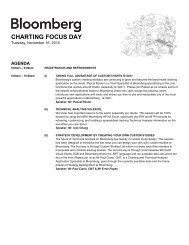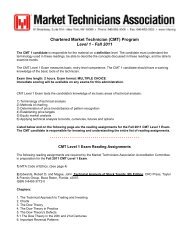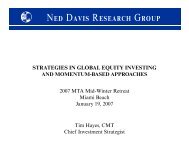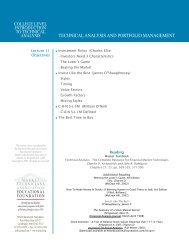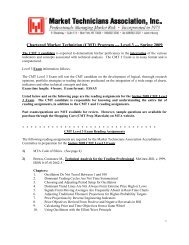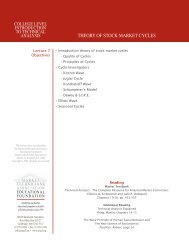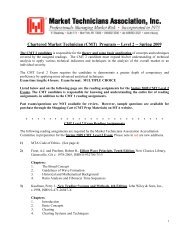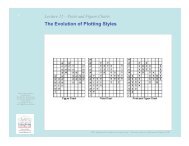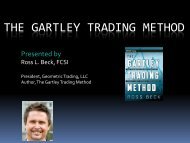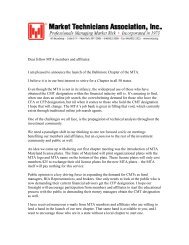Journal of Technical Analysis - Market Technicians Association
Journal of Technical Analysis - Market Technicians Association
Journal of Technical Analysis - Market Technicians Association
You also want an ePaper? Increase the reach of your titles
YUMPU automatically turns print PDFs into web optimized ePapers that Google loves.
24<br />
is an uneven match. The VPCI uses information from volume-weighted prices to gauge the health <strong>of</strong> existing trends, whereas OBV accumulates volume flows as<br />
directed by price changes to uncover hidden coils. Thus the conditions setup in this system, a trending market with apparent price direction, is one in which the<br />
VPCI is designed to succeed. Although, OBV was not necessarily setup for failure either, this study does illustrate how less savvy practitioners <strong>of</strong>ten fail to use the<br />
indicators’ information correctly or fail to coordinate the indicators properly.<br />
Table 2 Comparing Strategies’ Returns<br />
What if an investor had just used the MACD buy and sell signals within this same system, without utilizing the VPCI information? In this example, this investor<br />
would have lost out on nearly 12% annualized return, the difference between the VPCI’s positive 8.11% versus the MACD’s negative -3.88% rate <strong>of</strong> return, while<br />
significantly increasing risk. What if this investor had just employed a buy-and-hold approach? Although this investor would have realized a slightly higher return,<br />
he/she would have been exposed to much greater risks. The VPCI strategy returned nearly 90% <strong>of</strong> the buy-and-hold strategy return while avoiding about 60%<br />
less risk as measured by standard deviation. Looking at risk-adjusted returns another way, the five year Sharpe Ratio for the SPDR 500 was only .1 compared to<br />
the VPCI system <strong>of</strong> .74. Additionally, the VPCI investor would have been invested only 35% <strong>of</strong> the time, allowing the investor the opportunity to invest in other<br />
investments. During the 65% <strong>of</strong> the time the investor was not invested, he/she would have only needed a 1.84% money-market yield to exceed the buy-and-hold<br />
strategy. Moreover, this investor would have experienced a much smoother performance, without such precipitous capital draw downs. The worst annualized VPCI<br />
return was only a measly -2.71% compared to the underlying investments worst year <strong>of</strong> -22.81%, more than 20% difference in the rate <strong>of</strong> return! If an investor had<br />
invested in a money-market instrument, while not invested in the SPDR S&P 500, this VPCI strategy would not have experienced a single down year.<br />
Table 3 Annual Returns by Year<br />
Other Applications<br />
Further testing not covered in this research report suggests the VPCI may be used broadly across most markets exhibiting clear and reliable price and volume<br />
data such as individual equities, exchange traded funds, and broad indices. The raw VPCI calculation may also be used as a multiplier or divider in conjunction<br />
with other indicators, such as moving averages, momentum indicators, or raw price and volume data. For example, if an investor has a trailing stop loss order set<br />
at the five-week moving average <strong>of</strong> the lows, one could divide the stop price by the VPCI calculation. This would lower the price stop when price and volume are<br />
in confirmation, increasing the probability <strong>of</strong> keeping an issue under accumulation. However, when price and volume are in contradiction, dividing the stop loss by<br />
the VPCI would raise the stop price, preserving more capital. Similarly, using VPCI as a multiplier to other price, volume, and momentum indicators may not only<br />
improve reliability but it could increase responsiveness as well.<br />
Conclusion<br />
The VPCI reconciles volume and price as determined by each <strong>of</strong> their proportional weights. This information may be used to deduce likelihood <strong>of</strong> a current<br />
price trend continuing or reversing. I believe this study clearly demonstrates that adding the VPCI indicator to a trend-following system resulted in consistently<br />
improved performance across all major areas measured by the study. It is my opinion that in the hands <strong>of</strong> a pr<strong>of</strong>icient investor, the Volume Price Confirmation<br />
Indicator is a capable tool providing information which may be useful in potentially accelerating pr<strong>of</strong>its, reducing risk and empowering the investor towards sound<br />
investment decisions.<br />
Jo u r n a l <strong>of</strong> <strong>Technical</strong> <strong>Analysis</strong> • 2008 • Issue 65




